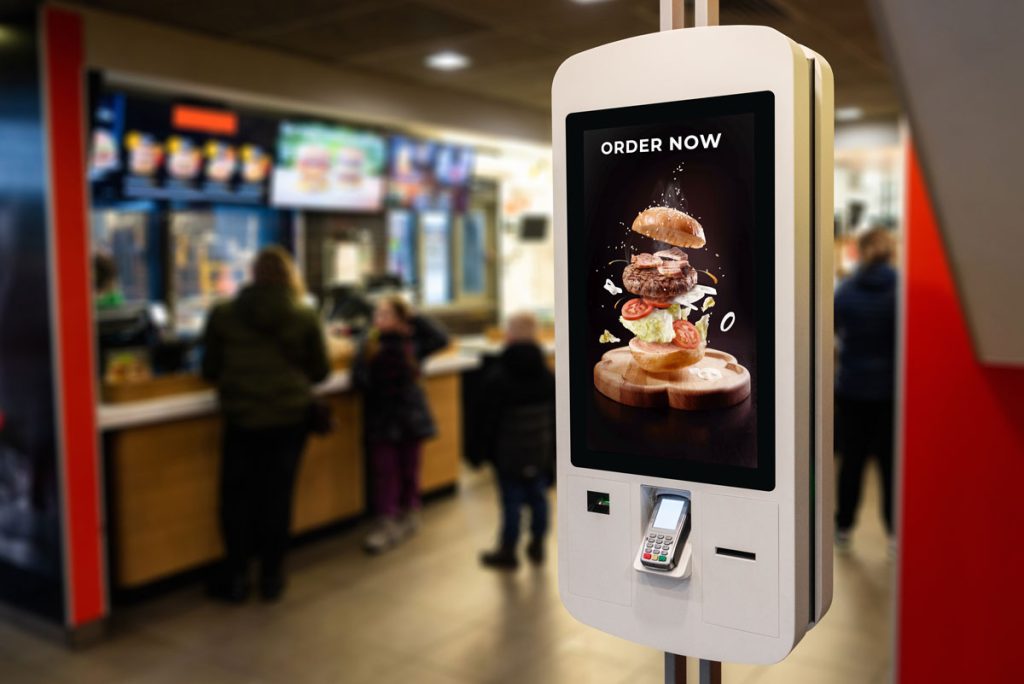No products in the cart.

Imagine you walk into a restaurant and you’re faced with a screen. It’s a self-ordering kiosk. There, you can scroll through attractive images of food and drinks, and place your orders without interacting with anyone. It’s easy, simple and best of all, you don’t have to wait for the restaurant’s employees to take your order.
Self-service, in some shape or form, is integrating itself into every part of the F&B industry, from fast food chains to fully-fledged restaurants. With technology like self-ordering kiosks, the increased ease of convenience and personalisation makes dining experiences more efficient for both the restaurant staff and guests.
Contents hide
Why You Need a Self-Ordering Kiosk
1. Reduce Wait Times
A large part of the customer experience is the speed and efficiency of your restaurant. As it turns out, 90% of customers don’t want to order if there’s a long line. So how do you combat this and make sure you don’t lose any potential customers? Self-ordering kiosks significantly speed up the ordering process , cutting overall order time by about 40%.
With a streamlined ordering system, guests can choose what they want easily and get any questions answered with a few buttons on the screen. They can also get information about ingredients, specials, promotions or possible substitutions without having to wait for a staff member to answer.
2. Optimise Labour Efficiency
Your guests don’t have to wait for your employees to be at the cashier; instead, they can easily order and pay for their orders through the self-ordering kiosks themselves. The orders are then sent directly to the kitchen printer or display for preparation, rather than going through a middle-man.
Another way of implementing self-ordering into your restaurant is through self-service iPads or QR code ordering on individual tables. Guests can browse through the menus at their leisure and start ordering without flagging down a server.
Meanwhile, your employees can focus their attention and energy on other tasks around the restaurant. It additionally means higher table turnover and hence, increased revenue.
3. Improve Order Accuracy
When relaying information to a server or cashier, customers’ orders can be wrongly sent to the kitchen staff for various reasons. A self-ordering kiosk eliminates potential miscommunication, misread orders and any mistyped keys into the POS system. Rather, they can easily see exactly what they are ordering through images and readable text and are able to review their orders before confirming the purchase. The customers’ orders will then be directly sent straight from the kiosk to the kitchen.
4. Increase Ticket Sizes
Upselling is a sales technique whereby customers are encouraged to spend more money on upgraded or premium versions of the original product they wanted. In the case of restaurants, upselling involves buying more expensive menu items or higher margin add-ons.
With a self-service kiosk, employees no longer need to be reminded to upsell items to customers. Instead, the guests are faced with an easy to use interface, large images of delicious food items, and detailed customisation options. Customer behaviour changes when interacting with a cashier is no longer required. Guests are more likely to choose more expensive options or more items in general. They might also opt for a drink and dessert where they previously wouldn’t have. Unlike people, the kiosk never forgets their script.
For example, after implementing self-ordering kiosks, McDonald’s reported a 20% increase in average order size and a 30% increase in average order value (Wavetec).
5. Enhance Customer Experience
Using the self-ordering interface, guests are able to better customise their orders with additions and substitutions that may not necessarily be possible otherwise. Again, this enhances order accuracy because servers may not be able to manually write down every change and convey them to the POS system or the kitchen staff. If they are using a POS system to take down orders, complicated orders may require clicking through multiple screens, increasing the chance for mistakes to occur.
Additionally, a self-service kiosk may offer more payment methods to choose from and it only takes a few simple taps to complete the transaction. The guests’ ordering experience is easy, simple and quick.
Conclusion
The reasons for investing in self-ordering kiosks for your restaurant don’t stop there. Here are some other advantages:
- Scale operations more efficiently
- Reduce manpower needs and costs
- Modernise your restaurant
- Increase sales & revenue
- Increase competitive edge
It’s clear that self-service is here to stay, and will continue to bring the F&B industry further into the digital world. Hence, staying up-to-date on the latest technology and methods of keeping customer foot traffic coming in is important to stay competitive.
If you’re interested in a self-service kiosk, feel free to contact EPOS for a free, non-obligatory demo to see what we can do for you.
• Written by Adrija Chakravarti
Interested to see what EPOS POS system can do for your business? Fill in your contact details and we’ll reach out to you to schedule a demo.
Frequently Asked Questions (FAQ)
What is a self-ordering kiosk?
A self-ordering kiosk is an automated ordering system where customers can place their orders directly from the kiosk, without the need for a human cashier.
What are the benefits of using a self-ordering kiosk?
Self-ordering kiosks can reduce waiting times, increase accuracy in orders, and provide customers with a contactless ordering experience. They can also save businesses money in labor costs.
How does a self-ordering kiosk work?
A customer interacts with the kiosk through a touch screen interface, selects their items, and pays for the order using a credit card, mobile payment, or cash. The kiosk then sends the order to the kitchen or bar for preparation.
Can self-ordering kiosks handle custom orders and modifications?
It depends on the specific kiosk, but many modern self-ordering kiosks have the ability to handle custom orders and modifications. Customers can specify their preferred ingredients, toppings, and modifications directly on the touch screen.
Was this article helpful?
YesNo



